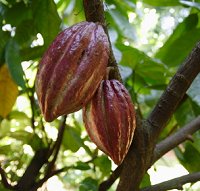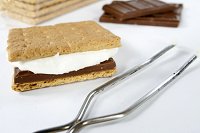Tag Archive: chocolate history
Chocolate: Around the World
October 7, 2011
If you are a self-proclaimed true blue chocoholic and want to satisfy your need for anything chocolate, then why don’t you head to the Field Museum in Chicago?
“Chocolate: Around the World”, a smash hit exhibit which sold more than 360,000 tickets in its first Field run in the year 2002 is back not only to entertain you, but also give you juicy and interesting information.
In the past nine years, “Chocolate” has already been to 22 other American museums and will go international when its present Field run is done in January, said the Field president and chief executive officer, John McCarter.
“Chocolate” is a combination of both the Field’s focus on anthropology as well as natural history and its attention to the origins of cacao beans and the role chocolate played in the past centuries. “This is one of the great combination stories,” McCarter said.
Read more
A Brief History of Brownies
September 22, 2011
The brownie, one of the most loved baked treat, was believed to be "invented" in America. Some references imply that brownies were originally made in New England at the beginning of the 20th century. Albeit the facts that it is basically cake-like and baked in a cake pan, brownies are considered as bar cookies rather than a cake.
Brownies can either be "cake-style" or "fudge-style”. Cake-style is that with the consistency of a cake, only richer and denser. On the other hand, fudge-style is more like, er, fudge than cake. It is the richer, denser, and creamier version of the brownie. What determines the style of brownie is the ratio of flour to chocolate and/or cocoa.
I hate to state the obvious but it’s apparent brownie derived its name from its dark brown color. But just like almost any food, the origin of the "brownie" is covered in myth. One of the legends told is that a chef added melted chocolate to biscuits by mistake. Another one states that a cook was baking a cake but didn't have enough flour and baked it anyway, thus, making a brownie.
Read more
Chocolate Heaven Since 1911
September 2, 2011
The title is one of the advertising slogans of Thorntons, a household name in UK for chocolate retailing. The company was established in 1911 by Joseph William Thornton who eventually turned the business over to his sons, Norman and Stanley Thornton. Since then, it has always been Britain’s go-to store when it comes to high-quality chocolates. This year, it celebrates its Centenary birthday. And what better way to celebrate their 100th birthday than sharing it with their customers?
This year, it celebrates its Centenary birthday. And what better way to celebrate their 100th birthday than sharing it with their customers?
The first ever Thortons chocolate shop was opened in Sheffield in the year 1911 and it was called the Chocolate Kabin where you are magically transported into a chocolate heaven as you step inside the store. Today, as a Centenary birthday treat, Thorntons wants to give their customers a chance to experience such delight. They excitedly bring you the recreated Thorntons Chocolate Kabin where a Golden Key to the chocolate factory is hidden. And the lucky winner gets to be Willy Wonka for a day! Isn’t that such a sweet treat?
Read more
The Beginning of Chocolate
August 25, 2011
Chocolate has been around for millennia now, and the history is extremely long and diverse. The earliest references of chocolate were over fifteen hundred years ago in the Central American Rain Forest, an ideal environment for the cultivation of the Cacao Tree because of the mix of high rain fall, temperature and humidity.
The Mayan culture worshiped the Cacao tree as they believed it was of divine origin and it symbolized life and fertility. Cacao is actually a Mayan word which meant “God Food”, modernly coined as “Food of the Gods”. The Mayans were believed to be brewing and drinking this spicy bittersweet beverage by roasting, grinding and fermenting the seeds of the Cacao Tree. This was intended for the wealthy and elite.
The Aztecs, like Mayans, also have their own version of the fermented drink and they called it Xocolatl, meaning “bitter water”. Their Emperor, Montezuma, allegedly believed that this was an aphrodisiac, and drank almost 50 cups a day. The beans were even used as currency and considered as treasure that when Spaniards came and searched for gold and silver, they found no more than the beans.
Read more
Farewell To Chocolate Exhibit
May 27, 2011
Anniston Museum is known for their collection of historical artifacts like fossils, mummies and wide selection of plant and animal exhibits. But Last January 29, 2011, Anniston Museum of Natural History opened their sweetest and tastiest exhibit for the public eye to see.
The museum featured a chocolate exhibit dedicated to the history and science revolving around chocolate. The huge exhibit almost occupied the entire lobby area of the museum.
People could take a look and explore the featured life story of chocolates with the use of videos, replicas, antique chocolate tins, and copies of old promotional magazines, wrappers and leaflets of different brands like Milky Way, 3 Musketeers and more. You could even smell the sweet aroma of beans and chocolate all over the place.
Read more
Peanut Butter and Chocolate
August 14, 2010
You can probably guess what PB&J means. Peanut Butter and Jelly. PB&J is a classic American combination mostly reminiscent of childhood. Now that you are grown up, I suggest you switch to a more sophisticated flavor combination – Peanut Butter and Chocolate. Can we call it PB&C?
The most accepted theory of who put peanut butter and chocolate together is the story of H.B. Reese. Mr. Reese started out as a dairy employee for Hershey Chocolate Company in the 1920’s. He soon ventured out to start his own company and began to manufacture a single product called peanut butter cups, known today as REESE'S Peanut Butter Cups.
Read more
Hot Fudge Sauce
July 31, 2010
Summer time is ice cream time – with hot fudge sauce of course!
Wow – it seems there are about as many different recipes for hot fudge sauce as there are types of ice cream to put them on.
From what I can tell (after reviewing many recipes) hot fudge sauce is different from ordinary chocolate sauce in that it’s really a chocolate fudge that never sets. Cream or milk, sugar, and butter are boiled until thickened so that it gets nice and gooey.
Read more
The Spread of Cacao Around the World
July 29, 2010
I was recently asked about the spread of Cocoa or Cacao trees around the world.

The Aztecs ground cacao into Xocoatl, a chocolate drink used mostly for spiritual and ceremonial rituals.
Hernan Cortés is credited with bringing cacao to Spain where it spread throughout Europe in the 1500’s and 1600’s.
Read more
S’mores
July 5, 2010
A S’more is considered a summer time classic by many. It brings back memories of camping and backyard barbeques. And, of course, it just tastes good.

Meanwhile put a piece of chocolate on a graham cracker. After the marshmallow turns a golden brown, you pull it off the stick, place it on top of the chocolate, and top with another graham cracker. The warm marshmallow melts the chocolate and voilà! a s’more is born.
Read more

